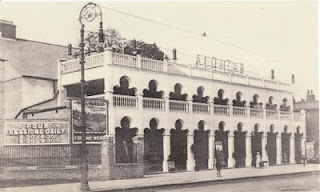 'The prettiest open-air boxing arena in the world' was how Boxing (forerunner to today's Boxing News) described the Alcazar, Edmonton, a leading London fight arena of the 1920s and '30s devastated in 1940 by a Luftwaffe bomb.
'The prettiest open-air boxing arena in the world' was how Boxing (forerunner to today's Boxing News) described the Alcazar, Edmonton, a leading London fight arena of the 1920s and '30s devastated in 1940 by a Luftwaffe bomb.Opened on 28 June 1913, the Alcazar was a cinema sited on the west side of Fore Street in Edmonton, almost opposite Fairfield Road and just a few yards north of Angel Road. The building was whitewashed and alcoved to look like a Moorish palace, and in the winter boxing was held in a large ballroom behind and adjoining it.
What made the venue exceptional, however, were the picturesque gardens behind the cinema. When the weather was warm fights were held outside in a ring that stood amid sloping grass banks, fruit trees in full bloom, flower beds and a stream. The ground was a sort of amphitheatre, bound by the stately trees in the gardens of the adjacent well-to-do houses that stretched to the railway line, which ran from Liverpool Street to Enfield Town.




